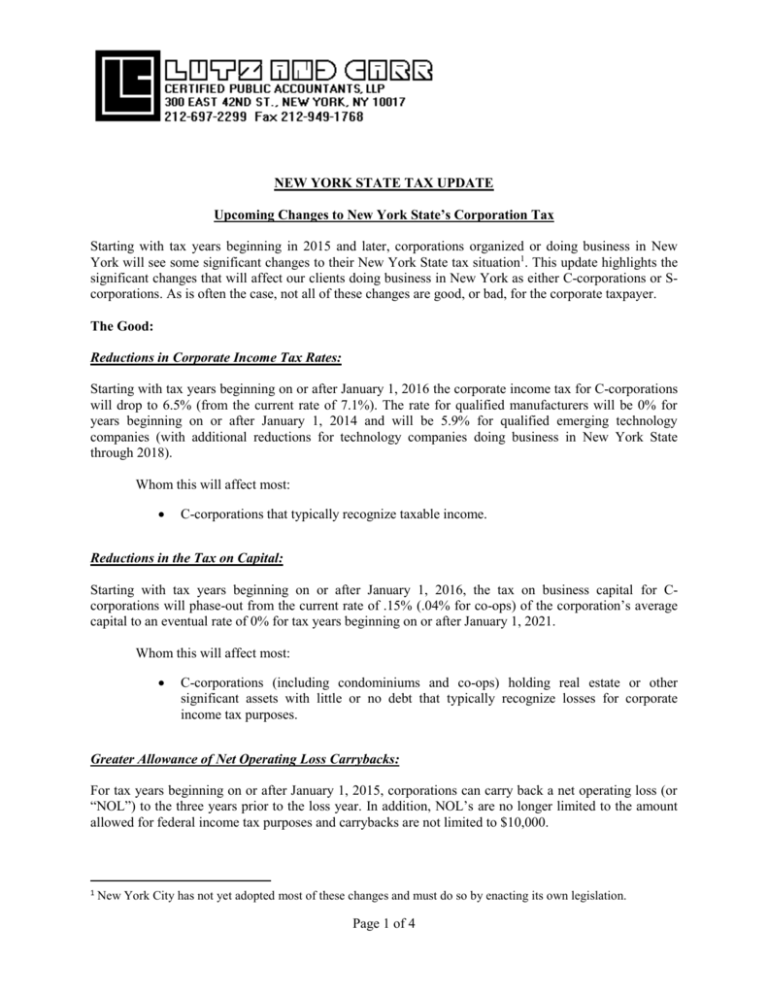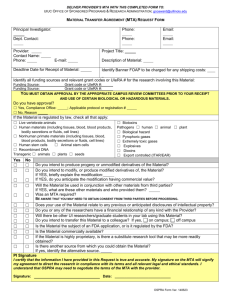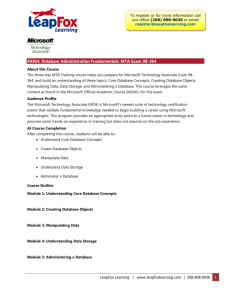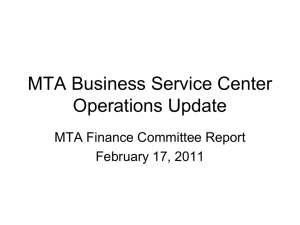Upcoming Changes to New York State's Corporation
advertisement

NEW YORK STATE TAX UPDATE Upcoming Changes to New York State’s Corporation Tax Starting with tax years beginning in 2015 and later, corporations organized or doing business in New York will see some significant changes to their New York State tax situation1. This update highlights the significant changes that will affect our clients doing business in New York as either C-corporations or Scorporations. As is often the case, not all of these changes are good, or bad, for the corporate taxpayer. The Good: Reductions in Corporate Income Tax Rates: Starting with tax years beginning on or after January 1, 2016 the corporate income tax for C-corporations will drop to 6.5% (from the current rate of 7.1%). The rate for qualified manufacturers will be 0% for years beginning on or after January 1, 2014 and will be 5.9% for qualified emerging technology companies (with additional reductions for technology companies doing business in New York State through 2018). Whom this will affect most: C-corporations that typically recognize taxable income. Reductions in the Tax on Capital: Starting with tax years beginning on or after January 1, 2016, the tax on business capital for Ccorporations will phase-out from the current rate of .15% (.04% for co-ops) of the corporation’s average capital to an eventual rate of 0% for tax years beginning on or after January 1, 2021. Whom this will affect most: C-corporations (including condominiums and co-ops) holding real estate or other significant assets with little or no debt that typically recognize losses for corporate income tax purposes. Greater Allowance of Net Operating Loss Carrybacks: For tax years beginning on or after January 1, 2015, corporations can carry back a net operating loss (or “NOL”) to the three years prior to the loss year. In addition, NOL’s are no longer limited to the amount allowed for federal income tax purposes and carrybacks are not limited to $10,000. 1 New York City has not yet adopted most of these changes and must do so by enacting its own legislation. Page 1 of 4 Under the current law, NOL’s can only be carried back for two years and up to a maximum of $10,000. These new carryback provisions, however, cannot be applied to tax years prior to January 1, 2015 (so losses arising in 2015 are still subject to the current law). Whom this will affect most: C-corporations who recognize taxable income in 2015 or later and recognize a taxable loss in a subsequent year. The Bad: Increases in the MTA Surcharge: For tax years beginning on or after January 1, 2015 the MTA surcharge rate will increase to 25.6% (the current rate is 17%) of the New York State corporate tax. For years beginning on or after January 1, 2016, the rate will be adjusted by the New York tax department. Whom this will affect most: All C-corporations that do business in the MTA district (the five boroughs of New York City and the counties of Nassau, Suffolk, Westchester, Rockland, Orange, Putnam and Dutchess). The In-Between: Bright-line Test for Filing New York Corporate Tax Returns and Paying New York Corporate Tax: For tax years beginning on or after January 1, 2015 a corporation organized in a state other than New York will be required to file a New York corporate income tax return (and pay New York corporate income tax, as applicable) if its New York sourced gross receipts are $1,000,000 or more (determined under the “market-based” approach, described below). The current law only requires a non-New York corporation to file a return and pay tax if it has physical presence (e.g. an office and/or employees) in the State. Similarly, a corporation will be deemed to be doing business in the MTA district if its gross receipts sourced to the district are $1,000,000 or more. Whom this will affect most: C-corporations and S-corporations that sell to customers in New York (and for C-corps, the MTA district) and were previously exempt from filing a New York income tax return Page 2 of 4 due to a lack of physical presence in New York State. Note that for New York nonresident shareholders of S-corporations, the income tax impact of this change will be significantly lessened due to the fact that your home state will allow a credit for any income taxes paid to New York. For example, you are a New Jersey resident and own 100% of an S-corporation organized in New Jersey. All of the S-corporation’s offices, equipment and employees are located in New Jersey. The S-corporation typically sells products to customers in New York totaling $2,000,000 of its total worldwide sales of $10,000,000. If the S-corporation’s taxable income is $1,000,000 for 2015, it must file a New York corporate tax return and report $200,000 (20% of $1,000,000) of New York taxable income. The shareholder of the S-corporation must also file a New York individual income tax return and pay New York income tax on the $200,000 of New York sourced income. New Jersey, as the resident state, will give the shareholder a credit for the New York tax paid. Changes in Determining How Much Income (or Loss) is Sourced to New York: For tax years beginning on or after January 15, 2015, New York State (and the MTA district) will implement a “market-based” approach to figure the percentage of a service-provider corporation’s (including digital service providers) taxable income (or loss) subject to New York (and MTA) corporate tax. Under this new approach, this percentage will be determined by applying a hierarchy of rules to determine the amount of sales to customers located in New York, as follows2: 1. The benefit is received in New York (and MTA); if unknown then, 2. Delivery destination is in New York (and MTA); if unknown then, 3. Application of the percentage of New York (and MTA) receipts to worldwide receipts from the preceding tax year; if unknown then, 4. Application of the percentage of New York (and MTA) receipts determined under methods 1 and 2 to worldwide receipts. In practice, this new rule sources a sale to New York (and the MTA district) for a service-provider if the customer is located in New York (and/or the MTA). Under current law expiring on December 31, 2014, if the cost of performing the service is greater in New York than in any other state, the sale is treated as New York sourced. Whom this will affect most: C-corporations and S-corporations previously not allocating sales to New York State (and for C-corps, the MTA district) based on where the costs of performing the services arose. Note that for non-resident shareholders of S-corporations, the income tax impact of this change 2 Receipts from the sale of personal property, trucking activities, rentals of real and personal and tangible personal property and royalties from the use of copyrights, patents, etc… will remained sourced to New York under the current law. Page 3 of 4 will be significantly lessened due to the fact that your home state will allow a credit for any income taxes paid to New York. For example, a Connecticut-based service-provider corporation historically allocated all of its taxable income to Connecticut due to the fact that all of its costs of performance occurred in Connecticut. Half of the corporation’s sales are to customers located in New York. Starting in 2015, the corporation must allocate half of its taxable income (or loss) to New York State. C-corporations and S-corporations that provide services in New York State (and for C-corps, the MTA district) where either the benefit is received outside of New York State or the customer is located outside of New York will be able to reduce their New York (and for Ccorps, the MTA) allocation percentages and reduce their New York State (and MTA) corporate tax. For example, a New York-based service-provider corporation historically allocated all of its taxable income to New York due to the fact that all of its costs of performance occurred in New York. Half of the corporation’s sales are to customers located in Connecticut. Starting in 2015, the corporation can allocate half of its taxable income outside of New York (Note that the corporation must also look to the Connecticut income sourcing rules to determine whether it must allocate taxable income to Connecticut). The Takeaway: These changes to the New York State corporate tax law are reflective of the State’s desire to make itself more attractive to businesses located in New York while looking to tax business located in other states. As a result, these changes are designed to reduce taxes for corporations doing business in New York and increase taxes for out-of-state corporations. Also reflected in these budget changes is coverage for the MTA’s monetary shortfalls. This is the largest single piece of corporate tax legislation passed in New York in decades and contains additional provisions affecting the corporate tax, the personal income tax and the estate tax that are beyond the scope of this memo. As your tax advisors we see it as our obligation to notify you of these upcoming changes and can guide you through any planning and compliance matters that may be necessary in response. Feel free to contact any of our team members at (212) 697-2299 to discuss. IRS Circular 230 Disclosure: To comply with requirements promulgated in U.S. Treasury Department regulations, we inform you that any U.S. federal tax advice contained in this communication (including any attachments) is not intended nor written to be used, and cannot be used, for the purpose of (i) avoiding penalties under the Internal Revenue Code or (ii) promoting, marketing or recommending to another person any transaction or matter addressed herein. Page 4 of 4





